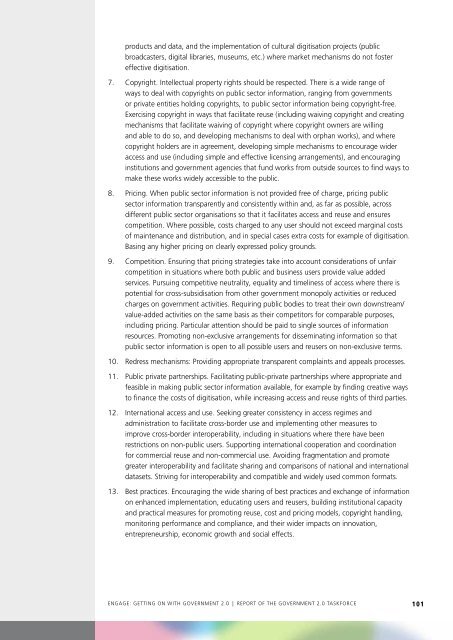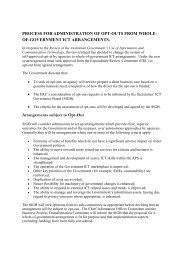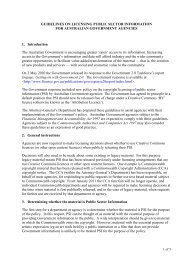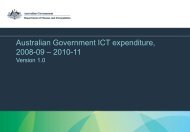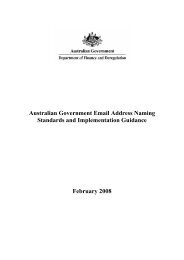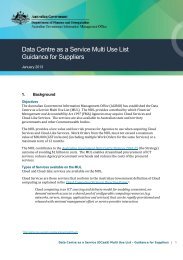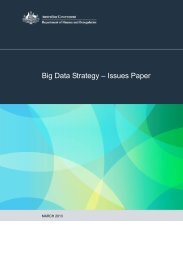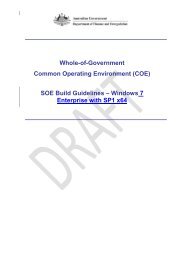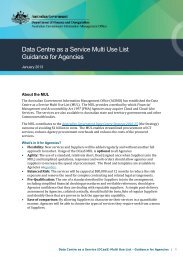Getting on with Government 2.0 - Department of Finance and ...
Getting on with Government 2.0 - Department of Finance and ...
Getting on with Government 2.0 - Department of Finance and ...
Create successful ePaper yourself
Turn your PDF publications into a flip-book with our unique Google optimized e-Paper software.
products <strong>and</strong> data, <strong>and</strong> the implementati<strong>on</strong> <strong>of</strong> cultural digitisati<strong>on</strong> projects (public<br />
broadcasters, digital libraries, museums, etc.) where market mechanisms do not foster<br />
effective digitisati<strong>on</strong>.<br />
7. Copyright. Intellectual property rights should be respected. There is a wide range <strong>of</strong><br />
ways to deal <strong>with</strong> copyrights <strong>on</strong> public sector informati<strong>on</strong>, ranging from governments<br />
or private entities holding copyrights, to public sector informati<strong>on</strong> being copyright-free.<br />
Exercising copyright in ways that facilitate reuse (including waiving copyright <strong>and</strong> creating<br />
mechanisms that facilitate waiving <strong>of</strong> copyright where copyright owners are willing<br />
<strong>and</strong> able to do so, <strong>and</strong> developing mechanisms to deal <strong>with</strong> orphan works), <strong>and</strong> where<br />
copyright holders are in agreement, developing simple mechanisms to encourage wider<br />
access <strong>and</strong> use (including simple <strong>and</strong> effective licensing arrangements), <strong>and</strong> encouraging<br />
instituti<strong>on</strong>s <strong>and</strong> government agencies that fund works from outside sources to find ways to<br />
make these works widely accessible to the public.<br />
<br />
8. Pricing. When public sector informati<strong>on</strong> is not provided free <strong>of</strong> charge, pricing public<br />
sector informati<strong>on</strong> transparently <strong>and</strong> c<strong>on</strong>sistently <strong>with</strong>in <strong>and</strong>, as far as possible, across<br />
different public sector organisati<strong>on</strong>s so that it facilitates access <strong>and</strong> reuse <strong>and</strong> ensures<br />
competiti<strong>on</strong>. Where possible, costs charged to any user should not exceed marginal costs<br />
<strong>of</strong> maintenance <strong>and</strong> distributi<strong>on</strong>, <strong>and</strong> in special cases extra costs for example <strong>of</strong> digitisati<strong>on</strong>.<br />
Basing any higher pricing <strong>on</strong> clearly expressed policy grounds.<br />
9. Competiti<strong>on</strong>. Ensuring that pricing strategies take into account c<strong>on</strong>siderati<strong>on</strong>s <strong>of</strong> unfair<br />
competiti<strong>on</strong> in situati<strong>on</strong>s where both public <strong>and</strong> business users provide value added<br />
services. Pursuing competitive neutrality, equality <strong>and</strong> timeliness <strong>of</strong> access where there is<br />
potential for cross-subsidisati<strong>on</strong> from other government m<strong>on</strong>opoly activities or reduced<br />
charges <strong>on</strong> government activities. Requiring public bodies to treat their own downstream/<br />
value-added activities <strong>on</strong> the same basis as their competitors for comparable purposes,<br />
including pricing. Particular attenti<strong>on</strong> should be paid to single sources <strong>of</strong> informati<strong>on</strong><br />
resources. Promoting n<strong>on</strong>-exclusive arrangements for disseminating informati<strong>on</strong> so that<br />
public sector informati<strong>on</strong> is open to all possible users <strong>and</strong> reusers <strong>on</strong> n<strong>on</strong>-exclusive terms.<br />
10. Redress mechanisms: Providing appropriate transparent complaints <strong>and</strong> appeals processes.<br />
11. Public private partnerships. Facilitating public-private partnerships where appropriate <strong>and</strong><br />
feasible in making public sector informati<strong>on</strong> available, for example by finding creative ways<br />
to finance the costs <strong>of</strong> digitisati<strong>on</strong>, while increasing access <strong>and</strong> reuse rights <strong>of</strong> third parties.<br />
12. Internati<strong>on</strong>al access <strong>and</strong> use. Seeking greater c<strong>on</strong>sistency in access regimes <strong>and</strong><br />
administrati<strong>on</strong> to facilitate cross-border use <strong>and</strong> implementing other measures to<br />
improve cross-border interoperability, including in situati<strong>on</strong>s where there have been<br />
restricti<strong>on</strong>s <strong>on</strong> n<strong>on</strong>-public users. Supporting internati<strong>on</strong>al cooperati<strong>on</strong> <strong>and</strong> coordinati<strong>on</strong><br />
for commercial reuse <strong>and</strong> n<strong>on</strong>-commercial use. Avoiding fragmentati<strong>on</strong> <strong>and</strong> promote<br />
greater interoperability <strong>and</strong> facilitate sharing <strong>and</strong> comparis<strong>on</strong>s <strong>of</strong> nati<strong>on</strong>al <strong>and</strong> internati<strong>on</strong>al<br />
datasets. Striving for interoperability <strong>and</strong> compatible <strong>and</strong> widely used comm<strong>on</strong> formats.<br />
13. Best practices. Encouraging the wide sharing <strong>of</strong> best practices <strong>and</strong> exchange <strong>of</strong> informati<strong>on</strong><br />
<strong>on</strong> enhanced implementati<strong>on</strong>, educating users <strong>and</strong> reusers, building instituti<strong>on</strong>al capacity<br />
<strong>and</strong> practical measures for promoting reuse, cost <strong>and</strong> pricing models, copyright h<strong>and</strong>ling,<br />
m<strong>on</strong>itoring performance <strong>and</strong> compliance, <strong>and</strong> their wider impacts <strong>on</strong> innovati<strong>on</strong>,<br />
entrepreneurship, ec<strong>on</strong>omic growth <strong>and</strong> social effects.<br />
Engage: <str<strong>on</strong>g>Getting</str<strong>on</strong>g> <strong>on</strong> <strong>with</strong> <strong>Government</strong> <strong>2.0</strong> | report <strong>of</strong> the government <strong>2.0</strong> taskforce<br />
101


